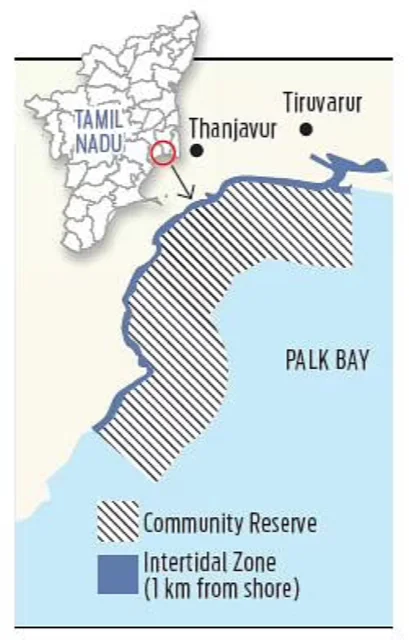UPSC Articles
India’s first dugong conservation reserve
Part of: GS Prelims and GS- III – Environment
Context The Government of Tamil Nadu will set up India’s first Dugong Conservation Reserve in the Palk Bay Dugong.
About the Conservation Reserve
- The Conservation Reserve will cover an area of 500kms.
- The proposed conservation area has the highest concentration of dugongs in the country.
- The reserve will span the northern part of the Palk Bay from Adirampattinam to Amapattinam.
- AS part of the CAMPA-Dugong Recovery Project, various surveys were conducted in the Palk Bay and Gulf of Mannar, from November 2016 to March 2019.
- Gulf of Mannar is a shallow bay area between the south eastern end of Tamil Nadu and western Sri Lanka.
About Dugongs
- The dugong , also called the sea cow, is a herbivorous mammal.
- It is the only living representative of the once-diverse family Dugongidae.
- The dugong is strictly a marine mammal.
- They graze on seagrass and come to the surface to breathe.
- They are found in over 30 countries and in India are seen in the Gulf of Mannar, Gulf of Kutch, Palk Bay, and the Andaman and Nicobar Islands.
- According to Wildlife Institute of India (WII) estimates, only 200-250 Dugongs are left in the wild, of which 150 are found in the Palk Bay and Gulf of Mannar in Tamil Nadu.
- Threats:
-
- The loss of seagrass habitats
-
- water pollution
-
- degradation of the coastal ecosystem due to developmental activities
-
- accidental entanglement in fishing nets
-
- collision with boats, trawlers.
- Conservation status
-
- IUCN- Vulnerable
-
- CITES: Appendix I
-
- Wild (Life) Protection Act, 1972: Schedule I
- The Government of India is also a signatory to the Conservation of Migratory Species (CMS) since 1983 where it has signed non-legally binding Memorandums of Understanding on the conservation and management of Siberian Cranes (1998), Marine Turtles (2007), Dugongs (2008) and Raptors (2016).
- Proper conservation is the only way to save dugongs from extinction.















